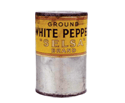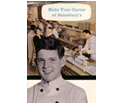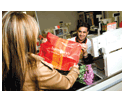Our history
-
more
1869
-
We opened our first store in Drury Lane.

Sainsbury's was founded in 1869 by John James and Mary Ann Sainsbury. Drury Lane was one of London's poorest areas and the Sainsburys' shop quickly became popular for offering high-quality products at low prices. Since 1869 we have grown from one shop to more than 800 today.
-
-
more
1882
-
We started to sell own-brand products

Having our own-label products has always been seen as the best way of offering choice and good value to customers. Our first own-label product in 1882 was bacon, which was smoked in our instore smoking ovens.
-
-
more
1898
-
Our longest established supplier – Lloyd Maunder – started supplying us with meat and poultry.

We have built up strong relationships with suppliers to make sure our customers always have the freshest food available. Our buyers have worked with suppliers since 1983 to reduce the number of additives where possible, particularly in children’s food, and we were the first to remove all of them from our own-brand soft drinks.
-
-
more
1914
-
We started to recruit women to help with colleague shortages during the First World War

During the war women helped run stores for the first time. They went to a new training school specially set up at Blackfriars.
-
-
more
1916
-
We set up our training school in Blackfriars, ensuring our colleagues were the best trained.

Our training was so well regarded by our competitors in the early 1900s that they advertised for “Sainsbury’s trained men”. This tradition of great training continues today, with programmes such as our Bakery apprenticeship scheme.
-
-
more
1944
-
We halved labels on our cans, to save paper and help the war effort.

In the First World War we introduced our rationing scheme, to make sure customers got a fair share of the food that was available. The scheme was so successful that the Government adopted the system during the Second World War.
-
-
more
1946
-
The first issue of our colleague magazine, the Journal, arrived instore

We’ve always given colleagues as much career advice as possible so they can make the most of their job. We even produced information about careers on vinyl records – a bit different from the DVDs we produce today.
-
-
more
1950s
-
Our self-service
stores opened, years before our competitors
Our store in Croydon was the first to change to self-service, in 1950, bringing an end to queuing at counters. Eventually, all stores became self-service but it’s hard to believe the last one was only converted in 1982.
-
-
more
1961
-
We became the first food retailer to computerise distribution.

Sainsbury's became the first food retailer to computerise the distribution of goods to its stores. The computer was so complex it had to be ordered two years in advance, and it took over from the mechanised Power Samas punched card system.
-
-
more
1969
-
Our own brand lines accounted for 50% of our turnover.

By the end of the 1960s Sainsbury's own brand lines accounted for more than 50% of the company's turnover.
-
-
more
1970s
-
We introduced the
first bakeries, fresh fish counters, petrol stations and coffee shops into our stores.
We’ve always put the needs of customers first. Since the war, travel has broadened our customers’ tastes and we’ve increased our ranges.
-
-
more
1975
-
Our first Savacentres opened, expanding our range to include non-food products.

It’s hard to imagine now what our stores looked like a hundred years ago. Stores were long, and narrow and a far cry from the modern, brightly lit and spacious stores our customers visit today.
-
-
more
1989
-
We introduced the first ever carrier bags made from recycled material.

Our reusable Bags for Life are made of 100% recycled material – no virgin crude oil is used in their production. We’ve always led the way with new and exciting technology in our stores. We also computerised our stock control and developed CFC-free refrigerants.
-
-
more
1991
-
To encourage our customers to reuse carrier bags, we launched our Penny Back scheme for charity.

Launching our CFC-free aerosols was much better for the environment. But caring for the environment is nothing new. In the early 1900s we even recycled rabbit skins!
-
-
more
1994
-
We were the first major supermarket in the UK to sell Fairtrade food.

We were the first major supermarket in the UK to sell Fairtrade food. By 1998 the range of Fairtrade products included orange juice, chocolate, tea and coffee.
-
-
more
2004
-
We launched the TU fashion range in 160 stores.

In September 2004 we launched the TU fashion range in 160 stores. The range included womenswear, menswear, kidswear, accessories, jewellery & lingerie
-
-
more
2005
-
We launched Try something new today, marking the end of a disappointing period in our history, and a return to what our customers want.

Our Try Tips are a great way for customers to get adventurous and Try something new today. They continue our long tradition of publishing recipes and giving our customers new ideas. The campaign, promoted in stores, newspapers, magazines and on TV, has been hugely successful, with over 7 million ‘Try’ cards picked up in stores.
-
-
more
2007
-
Our first Make the Difference day encouraging carrier bag reuse, was a massive success.

The first Make the Difference day – 27 April 2007 – focused on respect for our environment. For one day, Sainsbury’s became the first major UK supermarket to stop giving out free disposable carrier bags in its stores. Instead, we gave customers an estimated seven million free re-usable ‘Bags for Life’ (usually 10p) for their shopping. If customers keep and reuse the bags on future shopping trips, together we will have reduced the number of disposable carrier bags needed in the future.
-
-
more
2007
-
We were the first retailer to convert all our bananas to 100% Fairtrade.

We were the first retailer to convert all our bananas to 100% Fairtrade. Fish fingers became the first product in our range to use palm oil from certified sustainable sources. Our target for all products using sustainable palm oil is 2014.
-
-
more
2008
-
We were the first retailer to launch our own brand 1% fat milk.

We were the first retailer to launch our own brand 1% fat milk. In one year it attained a phenomenal 10% share of our milk range and is consumed in 2.5 million households. It is set to outsell skimmed milk by 2010.
-
-
more
2009
-
Sainsbury’s was the largest retailer to completely remove battery farmed eggs from its shelves.

Sainsbury’s was the largest retailer to completely remove battery farmed eggs from its shelves, ensuring over half a million hens will no longer be kept in battery cages. We were also awarded the Compassion in World Farming “Good Egg Award”
-



